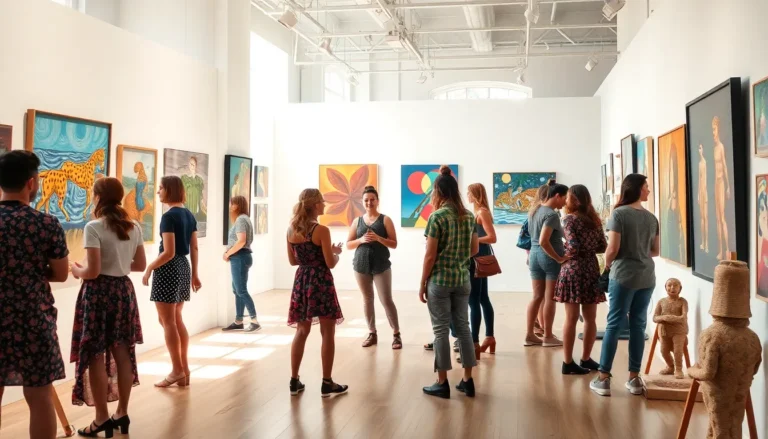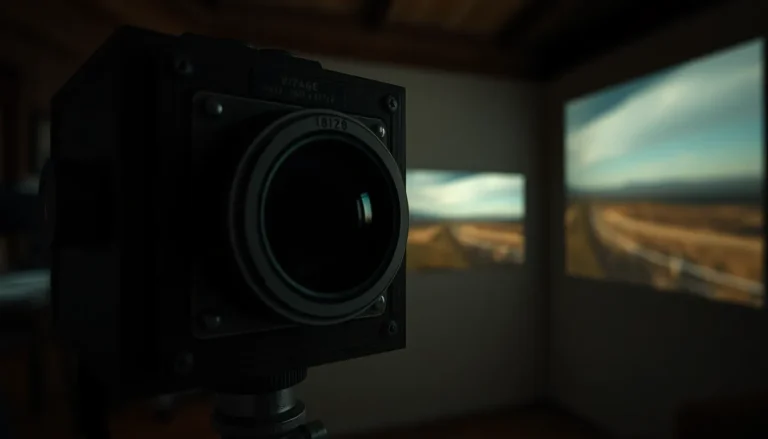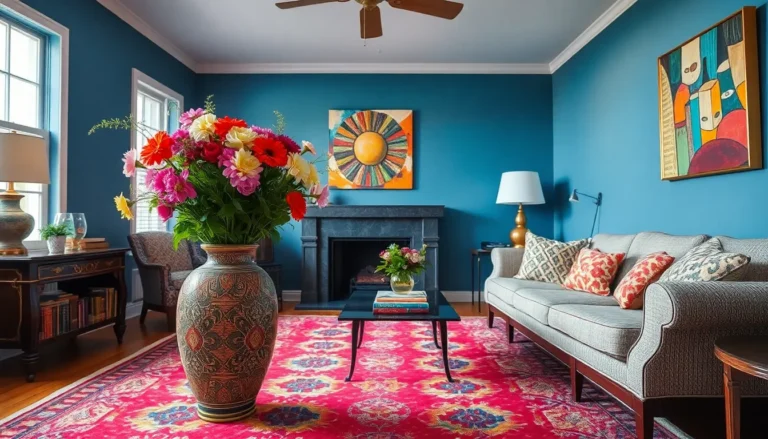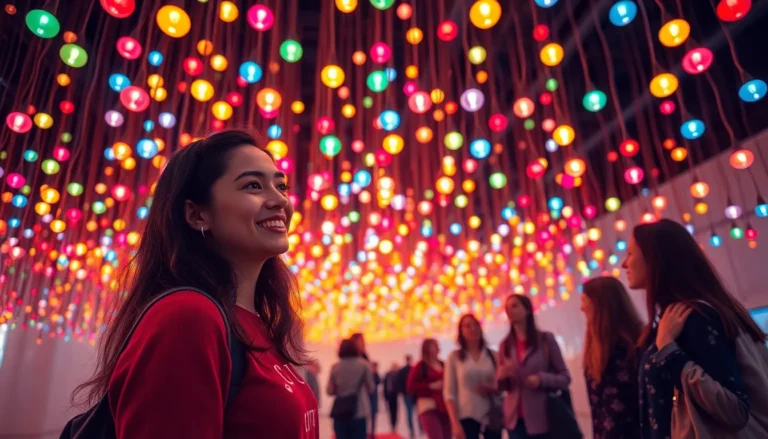Table of Contents
ToggleIn a world where art often feels like a puzzle missing a few pieces, modern renaissance art swoops in like a caped crusader, ready to save the day. This vibrant movement blends the timeless elegance of the Renaissance with contemporary flair, making it the perfect eye candy for anyone craving a feast for the senses. Imagine the classics, but with a twist—like a Mona Lisa sporting a pair of funky sunglasses.
As artists explore themes of identity, technology, and society, they invite audiences to join the conversation. This isn’t just about pretty pictures; it’s about challenging norms and sparking dialogue. So buckle up and get ready to dive into a world where brush strokes meet bold ideas, and every piece tells a story worth hearing. Whether you’re an art aficionado or just someone looking to impress at the next gallery opening, modern renaissance art has something for everyone.
Overview of Modern Renaissance Art
Modern renaissance art represents a significant evolution in artistic expression, merging traditional techniques with modern themes. This movement embraces elements like realism, symbolism, and abstract forms, often reflecting contemporary societal concerns. Artists involved in this genre frequently explore topics such as identity, technology, and the human experience.
Themes of rebirth and innovation dominate many works within this realm. The interplay of light and shadow, hallmark features of Renaissance painting, reemerges in modern pieces but with a contemporary twist. Techniques from old masters are revisited, yet adapted to resonate with today’s audiences. Artists like Kehinde Wiley and Yinka Shonibare, active in this movement, demonstrate how previous methodologies can inform modern narratives.
Practices often integrate diverse materials, blending traditional oils with mixed media or digital elements. Installation art and performance also find their place, expanding how audiences interact with the pieces. This evolution reflects a shift where the viewer’s participation becomes crucial in interpreting the artwork’s message.
Engaging with these artworks provokes discussions that challenge existing societal norms. Each piece tells a story, urging observers to reflect on their own experiences. Through modern renaissance art, creators invite everyone to participate in a dialogue about culture and identity, pushing boundaries and expanding the artistic conversation. This movement embodies both a respect for historical influences and a bold drive toward future possibilities.
Key Characteristics of Modern Renaissance Art

Modern renaissance art incorporates a multitude of defining characteristics that set it apart from previous movements. This dynamic form engages with both traditional and contemporary themes, inviting audiences to explore deep narratives.
Emphasis on Individualism
Individualism plays a central role in modern renaissance art. Artists often highlight personal identity and unique perspectives, reflecting the complexities of contemporary life. Creations express diverse backgrounds, experiences, and viewpoints, drawing on historical references to illustrate individuality. They enable viewers to connect intimately with the artist’s journey. Works often encourage self-reflection and foster dialogue about identity in society. By elevating personal narratives, modern renaissance art showcases the power of the individual in a shared cultural conversation.
Techniques and Mediums Used
Techniques and mediums used in modern renaissance art reveal its innovative spirit. Artists adopt classical techniques like chiaroscuro while integrating mixed media, digital components, or installations. Combining traditional oils with materials like wood, fabric, or metal expands creative possibilities. Digital art forms often emerge, linking the past with present technology. Each technique serves not just aesthetic purposes but also enhances storytelling. Contemporary artists challenge conventions, pushing boundaries and redefining art’s role. The fusion of old methods with modern themes captures the essence of this artistic movement, making artworks resonate in today’s world.
Influential Artists in Modern Renaissance Art
Modern renaissance art features artists who redefine traditional boundaries while paying homage to classical influences. Notably, several creators stand out due to their innovative approaches.
Notable Works and Contributions
Kehinde Wiley’s “Portrait of a Young Gentleman” blends historical portraiture with contemporary subjects, celebrating Black identity. Yinka Shonibare’s “The Scramble for Africa” critiques colonialism using vibrant textiles, sparking debates on cultural identity. Chuck Close’s massive portraits employ a grid technique to merge realism with abstraction, challenging perceptions of identity. These artists significantly contribute to modern renaissance art, compelling audiences to engage with societal narratives through a blend of heritage and modernity.
Artistic Movements and Trends
Connections exist between modern renaissance art and various artistic movements, such as realism and postmodernism. The focus on individuality aligns with contemporary trends exploring identity and self-expression. The integration of digital media reflects the influence of technology on artistic practices. Many artists experiment with installation art, blurring the lines between artwork and viewer, thus fostering interaction. Trends in this genre prioritize the merging of traditional techniques with contemporary themes, pushing the boundaries of artistic expression while inviting ongoing dialogue.
The Cultural Impact of Modern Renaissance Art
Modern renaissance art significantly influences cultural dialogue. By merging historical techniques and contemporary themes, this art form fosters discussions on societal issues. Artists often highlight diverse perspectives, reflecting the complexities of identity in today’s world. The movement encourages viewers to examine their own experiences while engaging with the artworks.
Themes of rebirth and innovation permeate these pieces. Many artworks reinterpret the interplay of light and shadow, a hallmark of classical painting, bringing it to new audiences. This approach resonates with people, inviting them into a conversation about culture and identity.
Kehinde Wiley, for instance, challenges traditional representations. His works address racial identity and power, drawing from classical portraiture while infusing modern relevance. Similarly, Yinka Shonibare critiques colonialism using vibrant textiles, blending historical context with contemporary commentary. These artists compel audiences to reflect on societal narratives, emphasizing the ongoing relevance of the topics they explore.
Installation art and performance pieces serve as additional avenues for engagement. These practices invite active participation, blurring the boundaries between artwork and viewer. Many installations evoke strong reactions, prompting observers to consider their role within the cultural landscape.
Digital elements further expand the genre’s reach. Artists experiment with mixed media, integrating traditional painting with modern technology. This fusion not only revitalizes classic methodologies but also invites new interpretations of identity and culture. As a result, modern renaissance art remains a dynamic and evolving movement, deeply connected to contemporary societal concerns.
Modern renaissance art stands as a testament to the evolution of artistic expression. By merging classical techniques with contemporary themes, it not only captivates but also challenges viewers to engage with pressing societal issues. This movement fosters a deeper understanding of identity and culture, encouraging dialogue that resonates across diverse audiences.
As artists continue to push boundaries and redefine norms, modern renaissance art remains a vibrant force in today’s creative landscape. Its ability to intertwine personal narratives with broader societal themes ensures that it will continue to inspire and provoke thought for years to come. The dialogue initiated by this movement is essential for understanding the complexities of modern life and the rich tapestry of human experience.







